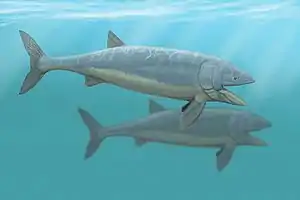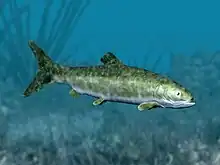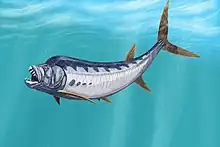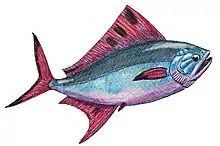Gillicus
Gillicus was a relatively small, 2 metres (6.6 ft) long ichthyodectiform fish that lived in central North America (Western Interior Seaway), Europe and East Asia, from the late Albian to the early Maastrichtian.[2][3]
| Gillicus Temporal range: | |
|---|---|
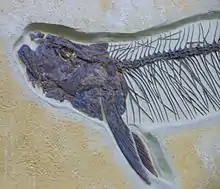 | |
| Fossil | |
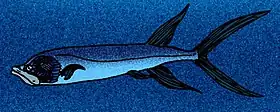 | |
| Life restoration of G. arcuatus | |
| Scientific classification | |
| Domain: | Eukaryota |
| Kingdom: | Animalia |
| Phylum: | Chordata |
| Class: | Actinopterygii |
| Order: | †Ichthyodectiformes |
| Family: | †Saurodontidae |
| Genus: | †Gillicus Hay, 1898 |
| Species | |
Description
Like its larger relative, Ichthyodectes ctenodon, Gillicus had numerous small teeth lining its jaws, and ate smaller fish by sucking them into its mouth, but the teeth of Gillicus are so small that the jaws appear almost toothless at first, which has led to the suggestion that Gillicus was also a filter-feeder.[3]
Gillicus was also eaten by its own relative, Xiphactinus. One particular 13 foot (4.0 m) long fossil specimen contains a nearly perfectly preserved 6 foot (1.8 m) long Gillicus arcuatus inside its ribcage.[4] The Gillicus bones have not been digested so the larger fish must have died soon after eating its prey. The cause of death may have been due to injuries, such as a ruptured major blood vessel, caused by the fin of the smaller fish as it struggled while being swallowed.[3] This fossil specimen, FHSM VP-333 (the Xiphactinus) and FHSM VP-333 (the Gillicus inside) is known as the “fish-in-a-fish” specimen and was collected by George F. Sternberg in 1952.[4] The specimen can be seen at the Sternberg Museum of Natural History in Hays, Kansas. Gillicus remains are also present in at least two other Xiphactinus specimens.[5]
Nearly all of the Gillicus specimens collected from the Smoky Hill Chalk are adults or subadults, which suggests that the early stages of their life were spent elsewhere.[3]
In 2009, the first specimen of Gillicus from Mexico was described.[2]
In 2021, the children's book The Plesiosaur's Neck[6] coined the common name "pug fish" for the Gillicus.[7]
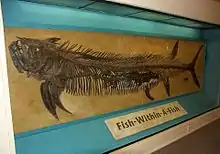
References
- Cavin, L.; Forey, P. L.; Giersch, S. (2013). "Osteology of Eubiodectes libanicus (Pictet & Humbert, ) and some other ichthyodectiformes (Teleostei): phylogenetic implications". Journal of Systematic Palaeontology. 11 (2): 115–177. doi:10.1080/14772019.2012.691559. S2CID 83807640.
- Alvarado-Ortega, Jesús; Porras- Múzquiz, Héctor (January 2009). "On the occurrence of Gillicus arcuatus (Cope, 1875) (Pisces, Ichthyodectiformest†) in Mexico". Boletín de la Sociedad Geológica Mexicana. 61 (2): 215–224. doi:10.18268/BSGM2009v61n2a9. ISSN 1405-3322.
- Everhart, Michael J. (2005). Oceans of Kansas : a natural history of the western interior sea. Bloomington: Indiana University Press. p. 344. ISBN 0-253-34547-2. OCLC 56982260.
- Rogers, Katherine L. (1999). The Sternberg fossil hunters : a dinosaur dynasty. Missoula, MT: Mountain Press. p. 290. ISBN 0-87842-404-0. OCLC 41431738.
- Bardack, David (1965-12-01). "Anatomy and evolution of chirocentrid fishes". University of Kansas Paleontological Contributions: 88. ISSN 0075-5044 – via Lawrence University of Kansas Paleontological Institute.
- "5 new books to read this week". The Independent. 2021-05-05. Retrieved 2021-05-07.
- Smith, Adam S.; Emmett, Jonathan (2021). The plesiosaur's neck. Adam Larkum. Preston: UCLan Publishing. ISBN 978-1-912979-42-4. OCLC 1242733894.
